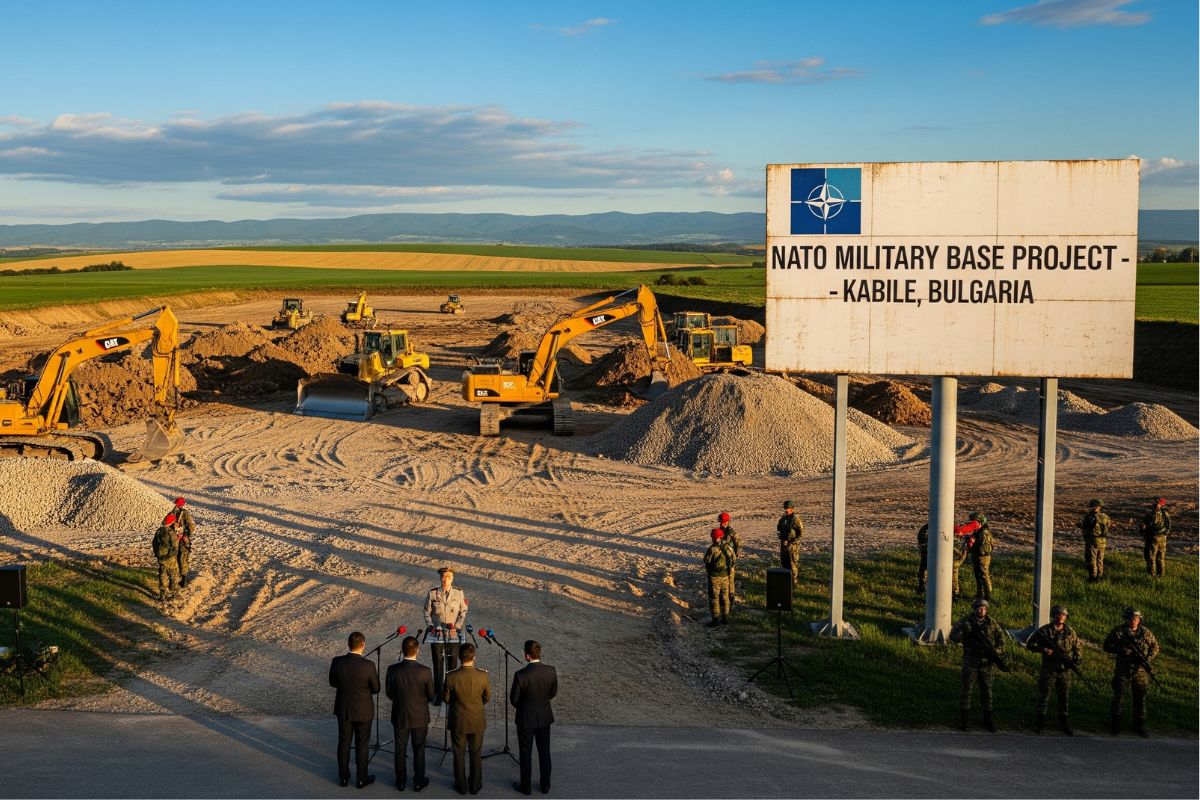Bulgaria is stepping up its defense game. On a quiet Friday announcement, the government under President Rumen Georgiev Radev revealed plans for a brand-new NATO military base. It’s set to rise in the Kabile region of Yambol Province, right where an existing battle group already hums with activity. This isn’t just any outpost; it’s a bold move to beef up NATO’s eastern defenses, especially with tensions simmering in the Black Sea area. Funny thing is, it’s all part of a bigger puzzle that started years ago, but kicked into high gear after Russia’s moves in Ukraine.
Think about it: Bulgaria, nestled on the edge of Europe, has always been a key player in regional stability. Joining NATO back in 2004, the country committed to collective defense, and now, with this base, it’s doubling down. The installation promises to host up to 5,000 troops, that’s brigade-level strength, and could even scale up to a full division if push comes to shove. Authorities haven’t pinned down exact timelines for shovels in the ground or when it’ll go live, but the buzz is building.
Why Now? Unpacking NATO’s Eastern Flank Strategy
Let’s back up a bit. NATO’s eastern flank, which stretches from the Baltic states down to the Black Sea, has been under the microscope since Russia’s annexation of Crimea in 2014. Then came the full-scale invasion of Ukraine in 2022, and suddenly, everyone was scrambling. Believe it or not, this Bulgarian base is a direct ripple from those events. At the 2023 Vilnius summit, NATO leaders hammered out plans to fortify the region, emphasizing rapid response and deterrence.
Bulgaria, sharing borders with Turkey, Greece, and the Black Sea, sits in a hotspot. It’s not just geography; it’s strategy. The Black Sea has turned into a contested zone, with naval maneuvers and energy routes at stake. By planting this base here, NATO aims to ensure quick deployments, kind of like having a fire extinguisher ready before the flames spread. Defense Minister Atanas Zapryanov called it a “permanent Bulgarian barracks area” that could expand if the security dial cranks up. No wonder they’re coordinating with NATO’s Support and Procurement Agency for the nitty-gritty.
Here’s the kicker: This isn’t isolated. It’s woven into a web of multinational efforts. Remember, NATO’s forward presence battlegroups popped up in 2017 across Estonia, Latvia, Lithuania, and Poland, then expanded post-Ukraine. Bulgaria got its own in 2022, led by Italy, and now this base will supercharge it.
Inside the Kabile Base: What to Expect from the New Facility
Picture this, a sprawling complex in Kabile, incorporating the nearby Bezmer Air Base. It’s designed for joint use between Bulgarian forces and NATO allies, blending seamlessly into existing setups. Currently, there’s a multinational battle group of about 1,200 to 1,300 troops hunkered down there, but the upgrade? Massive. We’re talking infrastructure for 5,000 soldiers, complete with barracks, training grounds, and logistics hubs.
The base won’t just sit idle. It’ll support rapid responses, hosting everything from armored vehicles to anti-tank units. Expansion potential means it could handle a division-sized force, that’s tens of thousands if needed. And the location? Smart. It’s roughly 90 kilometers from Burgas, a bustling Black Sea port with an international airport and rail links to Sofia and Plovdiv. Easy access for supplies, troops, you name it.
Funding-wise, it’s no small potatoes. The tab’s over €100 million, with NATO chipping in from its general budget. Bulgaria’s pitching in too, aligning with its ramped-up defense spending, hitting 2% of GDP in 2024 and eyeing 3.5% by 2032. This cash flow isn’t just for bricks and mortar; it’s about modernizing, ensuring the base can pivot quickly in crises.
- Key Features Planned: Permanent accommodations for battle groups, expandable to brigade or division scale.
- Strategic Integration: Ties into Bezmer Air Base for air support, enhancing overall readiness.
- Timeline Teasers: Construction’s greenlit, but exact start and finish dates remain under wraps.
Army Chief Admiral Emil Eftimov stressed the focus on “sufficient troops for quick and effective action”. It’s practical, if you ask me, no overkill, just what’s needed to deter threats.
Who’s Involved? A Multinational Force Takes Shape
This base isn’t a solo act. Italy’s at the helm, contributing over 700 troops and 50-plus pieces of gear to the current group. They’re the framework nation, steering the ship. But it’s a team effort: The U.S. sends Stryker armored vehicles, the UK’s Royal Irish Regiment brings infantry muscle, and Greece chips in an anti-tank platoon.
Don’t forget the locals, Bulgaria’s 42nd Mechanized Battalion is in the mix, alongside contingents from Turkey, North Macedonia, Montenegro, and Albania. It’s a melting pot of NATO allies, all drilling together for cohesion. The U.S. even shares the Novo Selo base nearby, about 150 kilometers away, for joint training.
These collaborations aren’t new. Since 2006, U.S. and Bulgarian forces have run exercises at Novo Selo, focusing on tank gunnery, urban assaults, and more. Rotations bring in up to 550 soldiers at a time, funded by programs like Foreign Military Financing. Community ties? They’re there too, think language exchanges with local schools. It’s building goodwill alongside defenses.
Expanding on that, the multinational setup ensures interoperability. Troops train in everything from reconnaissance to chemical defense, sharing tactics and tech. With the Kabile base, this synergy gets a permanent home, potentially hosting larger formations for sustained operations.
Economic Boost and Local Impacts: More Than Just Military Might
Here’s where it gets interesting for everyday folks. The project promises economic perks for Yambol Province and beyond. Construction alone will create jobs, think builders, suppliers, and maintenance crews. Once operational, it’ll need ongoing support: food, fuel, repairs. The Bulgarian army highlighted benefits through “construction, maintenance, and supply operations”.
Regionally, it’s a win. Kabile’s proximity to Burgas means better infrastructure ties, possibly spurring growth in transport and logistics. And with NATO funding flowing in, it’s like an investment injection without Bulgaria footing the entire bill.
But let’s be real: These developments can stir local debates. Some might worry about noise, traffic, or environmental tweaks. Yet, the government frames it as a net positive, emphasizing job creation and regional stability. If I’m honest, it’s a balancing act, security gains versus community adjustments.
Broader picture? Bulgaria’s pouring €6 billion into dual-use infrastructure: roads, rails, even fuel pipelines that serve both civilian and military needs. The EU’s kicking in €807 million via its Military Mobility Initiative. It’s all interconnected, making the Kabile base a cog in a larger machine.
Bulgaria’s Defense Evolution: From Post-Cold War to Frontline Ally
To really grasp this, we need to zoom out. Bulgaria’s military journey post-Communism has been transformative. After the Iron Curtain fell, it shifted from Warsaw Pact ties to NATO aspirations, joining in 2004 alongside six others. That meant overhauling forces, adopting Western standards, and contributing to missions in Afghanistan and Iraq.
Fast forward to today: Russia’s Ukraine aggression flipped the script. Bulgaria upped its game, hosting that initial battle group in 2022. Defense spending? From lagging below 2% to hitting the mark in 2024, with eyes on 3.5% by 2032. It’s funding F-16 jets, Stryker vehicles, and base upgrades like Graf Ignatievo’s €72 million facelift.
The Kabile project fits right in. It’s not just about troops; it’s infrastructure for the long haul. NATO’s post-Vilnius strategy calls for stronger deterrence in Black Sea nations. Bulgaria, with its coastline and borders, is pivotal. The base complements efforts like the Novo Selo joint facility, where U.S. rotations hone skills in live-fire drills.
Admiral Eftimov noted coordination with NATO agencies for seamless execution. Meanwhile, international players like the U.S. Army Corps of Engineers are involved in upgrades elsewhere. It’s a web of partnerships ensuring Bulgaria isn’t going it alone.
Strategic Implications for the Black Sea Region and Beyond
Step back, and you see the ripple effects. The Black Sea isn’t just water; it’s a gateway for energy, trade, and potential conflict. With Russia flexing in Ukraine, NATO’s eastern flank needs fortifying. This base in Kabile bolsters that, providing a hub for quick reactions.
For Bulgaria, its sovereignty and security are wrapped in alliance strength. “This is a strategic step to strengthen the defense capabilities of Bulgaria and NATO, ensuring a rapid response to any threat,” the government stated. No hyperbole there; it’s factual.
Neighboring Romania and Turkey watch closely, similar enhancements are underway across the region. Brave Romania’s tweet highlighted the 5,000-troop capacity as part of flank strengthening. It’s collective, you know? One nation’s base supports the whole.
Potential challenges? Funding timelines, as some projects face delays. But the momentum’s there, with EU and U.S. backing. The base could evolve, hosting larger forces if tensions escalate.
Looking Ahead: What This Means for NATO’s Future Posture
As construction looms, questions linger. Will it deter aggression effectively? How will locals adapt? One thing’s clear: This base marks Bulgaria’s firm stance in NATO’s orbit.
It’s more than concrete and steel. It’s about readiness in an unpredictable world. With partial NATO funding and multinational input, it’s a shared burden. For the region, economic upsides could soften any disruptions.
In the end, or rather, as things unfold, this development underscores NATO’s adaptability. From Vilnius decisions to Kabile groundwork, it’s a proactive defense. Bulgaria, once on the periphery, now stands frontline.
But wait, there’s more to chew on. Let’s dive deeper into the historical context that led us here. Bulgaria’s NATO integration wasn’t overnight. Post-1989, it dismantled Soviet-era structures, reforming its military under democratic oversight. By 1997, it joined the Partnership for Peace, a stepping stone to full membership. That 2004 accession? A milestone, aligning with the EU entry in 2007.
Challenges persisted, though. Budget constraints meant defense spending hovered low until recently. The Ukraine crisis changed that, prompting a reevaluation. Now, with 2% GDP committed and climbing, Bulgaria is investing in capabilities like the Graf Ignatievo upgrades for F-16s, due by 2025.
The Kabile base ties into this modernization wave. It’s not isolated; consider the €6 billion logistics plan, enhancing roads and rails for military mobility. Dual-use means civilian benefits, too, better highways for everyone. The EU’s Military Mobility Initiative supports this, funneling funds for cross-border efficiency.
On the multinational front, Italy’s leadership is key. As a framework nation, they’ve deployed over 700 personnel, integrating with allies. U.S. Strykers add mobility, and the UK’s regiment brings experience from global ops. Greece’s anti-tank platoon counters armored threats, while Balkan nations like Albania and Montenegro foster regional unity.
Training’s a big piece. At Novo Selo, exercises simulate real scenarios: urban assaults, chemical defenses. These build trust, ensuring that when the call comes, forces mesh seamlessly. Community outreach, language classes, and cultural swaps soften the military footprint.
Economically, the base could transform Yambol. Jobs in construction: welders, engineers, logisticians. Supply chains for food, fuel, and local businesses thrive. Burgas’s connectivity amplifies this, potentially boosting tourism and trade.
Strategically, it’s a deterrent. Positioning near the Black Sea signals resolve. Russia’s actions in Ukraine heightened Black Sea risks, naval blockades, and missile strikes. NATO’s response: Enhanced forward presence, including this base.
Comparisons? Romania’s Mihail Kogălniceanu base hosts U.S. troops, similarly fortifying the flank. Turkey, a NATO heavyweight, balances Black Sea dynamics. Together, they form a shield.
Potential expansions: The base’s design allows scaling. From 1,300 now to 5,000, or more. Admiral Eftimov’s words ring true, sufficient for effective action.
Funding details: €100 million initial estimate, but with NATO’s pot, it eases Bulgaria’s load. The alliance’s Security Investment Program covers strategic assets. U.S. contributions via the European Deterrence Initiative add layers.
Industry players? Bulgarian firms like Glavbolgarstroy handle local works, while internationals like Bilfinger Berger eye NATO contracts. It’s a boon for the sector.
Risks? Geopolitical shifts could alter plans. But the current trajectory points to completion by 2026 for some phases.
In wrapping this, though it’s ongoing, the Kabile base embodies NATO’s evolution. From Cold War relic to modern deterrent, Bulgaria’s role grows. This project, amid global uncertainties, reinforces collective security. Watch this space; it’s just the beginning.






















